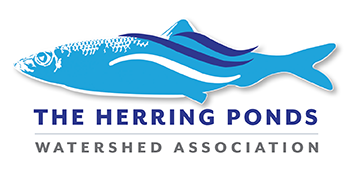Water Quality Committee Report Fall 2023
Don Williams, Water Quality Committee Co-Chair
We have recently had some very good news for the Herring Ponds Watershed! Thanks to the Water Quality Plan and to diligent research by the Management Implementation Committee (Jack Kedian, Geri Williams. Paul Denoncourt, Jerry Levine, Tom O’Brien, Brian Harrington, Jim Smith, Lee Pulis, and I), Kim Tower and David Gould from the Plymouth Department of Marine and Environmental Affairs, and our SMAST consultant, Ed Eichner, we have been able to choose installation of a Permeable Reactive Barrier (PRB) in the Carters River between Little Herring Pond (LHP) and Great Herring Pond (GHP) as an interim-term way to remove some of the phosphorus that causes our cyanobacteria blooms . Although the best long-term improvement that we can make is to provide sewers to the homes north and west of Great Herring and Little Herring Ponds, the PRB should buy us enough bloom-free time to enjoy our pond without toxic blooms while finding a way to provide sewers.
 The Water Quality Plan helped in several important ways. Thanks to all of you for your contributions to this effort. First, it identified phosphorus as the watershed pollutant that must be removed. Second, LHP was found to be the single largest source of phosphorus in GHP. Third, most of the phosphorus in LHP comes from septic systems in Ponds of Plymouth. Finally, the plan outlined the interim-term alternatives to a watershed sewer system that can be used until the latter can be planned, designed, and constructed.
The Water Quality Plan helped in several important ways. Thanks to all of you for your contributions to this effort. First, it identified phosphorus as the watershed pollutant that must be removed. Second, LHP was found to be the single largest source of phosphorus in GHP. Third, most of the phosphorus in LHP comes from septic systems in Ponds of Plymouth. Finally, the plan outlined the interim-term alternatives to a watershed sewer system that can be used until the latter can be planned, designed, and constructed.
The ”very good news” is that David Gould has proposed an Article for Fall Town Meeting requesting that he be able to spend $37,800 from the Solar Panel fund (provided by the company that installed the solar panel arrays on Plymouth town land, NOT by taxpayers). The Herring Ponds Watershed Association will contribute $5,000 toward the cost. The money will be spent on: a) gathering more baseline phosphorus data that will be used to evaluate the effectiveness of the PRB, b) installation of the PRB for use as early as July and August 2024, and c) an additional report by Ed Eichner evaluating the effectiveness of the PRB.
This is a huge step forward for our watershed. To our knowledge, the PRB technology (use of iron filings to remove phosphorus) has only been tried on ground water, not in streams. If successful, our efforts will be important steps forward in prevention of cyanobacteria blooms in Plymouth and elsewhere. The cost is not great, does not involve taxpayer dollars, and will advance technology dealing with cyanobacteria blooms.
Geri has taken pond samples during the spring and summer and used a fluorometer to measure the amount of cyanobacteria in GHP. We were glad to see that although cyanobacteria increased marginally in July, it started decreasing in late July and continues to decrease. The level was very low the entire time. Water samples have been taken each month since April and sent to be analyzed for cyanobacteria counts and the level of the toxin microcystin. The results so far this year have shown microcystin levels of 1 or less than 1 parts per billion, which is barely detectable and very low counts of cyanobacteria.
Total phosphorus from the LHP bog, spring, north, central, south sluiceway, and from GHP has remained quite low from April through August.
E.coli in GHP during the months of June, July, and August remained much lower than the swimming danger point.
With the help of Sara Grady and her daughter, Molly, Jerry and I looked for invasive plant species in GHP. Our preliminary results showed none but we await Sara’s final report.
We continue to take monthly total phosphorus samples and flow rate measurements at the ingress and egress of Great Herring Pond so that we will be able to know baseline monthly phosphorus levels.
Since Elbow Pond is in our watershed, is susceptible to pollution because it has many waterfront houses, neither ingress nor egress, and is upstream from the aquifer flow into GHP, we have taken water samples for them for evaluation. No significant change in the amount of pollution has occurred on Elbow Pond over the last three years. This year’s samples have not been evaluated as yet.

I WANT TO THANK EVERYONE INVOLVED WITH THIS VERY CAREFUL, INTELLIGENT AND TIME CONSUMIMG WORK THAT CAN BENEFIT NOT ONLY THOSE OF US ON GREAT HERRING POND BUT ALL WATER AREAS WITH NEW AND USEFUL INFORMATION. MY FAMILY AND I ARE VERY GRATEFUL FOR YOUR WORK, THAT HAS ALLOWED US TO ENJOY THE POND.I LOOK FORWARD TO YOUR REPORTS AND INFORMATION ON INNOVATIONS.